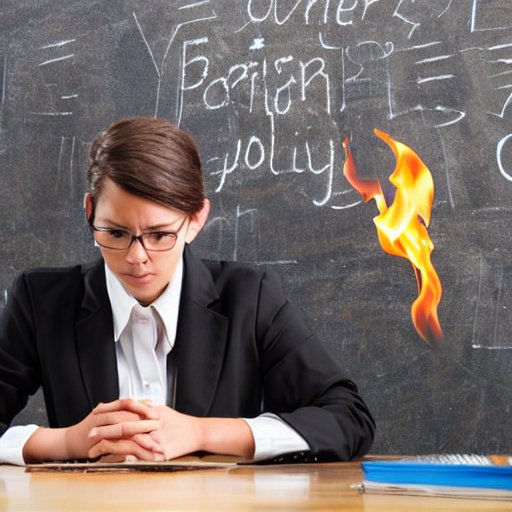Are you a teacher experiencing burnout? Learn about the signs of burnout in teachers and find out how you can prevent it from affecting your life and work. Read our guide now.
Table of Contents
Introduction to the signs of burnout in teachers
Definition of burnout
Burnout is a state of chronic physical and emotional exhaustion, often accompanied by feelings of cynicism and detachment from work. It is a condition that can affect individuals in high-stress professions, such as teaching. Teachers experiencing burnout may exhibit signs such as constant fatigue, decreased motivation, and a sense of ineffectiveness in their role. This can have a significant impact on their overall well-being and job performance. Recognizing the signs of burnout in teachers is crucial in order to provide appropriate support and intervention to prevent further negative consequences.
Importance of recognizing burnout in teachers
Recognizing burnout in teachers is of utmost importance in order to support their well-being and ensure the quality of education they provide. Burnout can have detrimental effects on teachers’ physical and mental health, leading to decreased job satisfaction, increased absenteeism, and even attrition from the profession. By identifying the signs of burnout early on, schools and educational institutions can take proactive measures to prevent and address burnout, such as providing support systems, professional development opportunities, and promoting a positive work-life balance. Moreover, recognizing burnout in teachers allows for the implementation of strategies to promote teacher resilience and overall well-being, ultimately benefiting both educators and students.
Purpose of the article
The purpose of this article is to explore the signs of burnout in teachers. Burnout is a common phenomenon in the field of education, and it can have serious consequences on the well-being and effectiveness of teachers. By identifying and understanding the signs of burnout, educators can take proactive steps to prevent and address this issue. This article aims to provide valuable insights into the indicators of burnout in teachers, helping both educators and educational institutions create a supportive and healthy work environment.
Causes of burnout in teachers

Workload and job demands
Teachers often experience burnout due to high workload and job demands. The demanding nature of their profession, including long working hours, excessive paperwork, and the pressure to meet the needs of diverse students, can take a toll on their mental and physical well-being. Additionally, teachers are expected to juggle multiple responsibilities such as lesson planning, grading, and extracurricular activities, which can lead to feelings of overwhelm and exhaustion. It is crucial for educational institutions to recognize the signs of burnout in teachers and provide the necessary support and resources to prevent and address this issue.
Lack of support and resources
Lack of support and resources is a significant factor contributing to burnout in teachers. When educators do not receive the necessary support from their colleagues, administrators, or the school system as a whole, it can lead to feelings of frustration, helplessness, and overwhelm. Additionally, a lack of resources, such as adequate teaching materials, technology, and professional development opportunities, can further exacerbate the stress and workload for teachers. Without the necessary support and resources, teachers may struggle to meet the demands of their profession, resulting in increased burnout rates.
Emotional and psychological factors
Emotional and psychological factors play a crucial role in identifying the signs of burnout in teachers. The demanding nature of their profession, coupled with excessive workload and high expectations, can take a toll on their mental well-being. Constant exposure to stress, pressure to meet deadlines, and dealing with challenging students or difficult parents can lead to emotional exhaustion and a sense of helplessness. Moreover, the lack of support and recognition from colleagues and superiors can further contribute to feelings of burnout. It is important to address these emotional and psychological factors to prevent and manage burnout among teachers.
Signs and symptoms of burnout in teachers

Physical exhaustion
Physical exhaustion is one of the key signs of burnout in teachers. Constantly dealing with the demands of the job, such as long hours, heavy workloads, and the pressure to meet deadlines, can take a toll on their physical well-being. Teachers experiencing physical exhaustion may feel constantly tired, lacking energy, and have difficulty sleeping. They may also experience physical symptoms such as headaches, muscle tension, and frequent illnesses. It is important for teachers to recognize these signs and prioritize self-care to prevent further burnout.
Emotional exhaustion
Emotional exhaustion is a common symptom of burnout in teachers. It is characterized by a feeling of being emotionally drained and overwhelmed, often resulting from the constant demands and pressures of the teaching profession. Teachers experiencing emotional exhaustion may find it difficult to connect with their students on an emotional level and may feel a sense of detachment or apathy towards their work. This can lead to decreased motivation, increased irritability, and a reduced ability to cope with stress. It is important for teachers to recognize and address emotional exhaustion early on to prevent further burnout and maintain their overall well-being.
Cognitive difficulties
Cognitive difficulties are one of the key signs of burnout in teachers. When experiencing burnout, teachers may find it increasingly challenging to concentrate and focus on their tasks. They may struggle with memory retention, making it difficult to recall important information or instructions. Additionally, decision-making and problem-solving abilities may be impaired, leading to a decrease in overall cognitive function. These cognitive difficulties can have a significant impact on a teacher’s ability to effectively carry out their responsibilities in the classroom, ultimately affecting the quality of education provided to students.
Impact of burnout on teachers
Decreased job satisfaction
Burnout in teachers can often lead to decreased job satisfaction. When teachers experience burnout, they may start to feel disengaged from their work and lose the passion they once had for teaching. This can result in a lack of motivation and enthusiasm, making it difficult for teachers to find joy in their daily tasks. Additionally, burnout can lead to feelings of frustration and exhaustion, further contributing to a decrease in job satisfaction. It is important for schools and educational institutions to recognize the signs of burnout in teachers and provide support and resources to help prevent and address this issue.
Increased absenteeism
Increased absenteeism is one of the key signs of burnout in teachers. When teachers are experiencing burnout, they may find themselves frequently calling in sick or taking more personal days. This can be due to physical and emotional exhaustion, as well as a lack of motivation and engagement in their work. The increased absenteeism not only affects the teachers themselves, but also has an impact on the students and the overall functioning of the school. It is important for schools and educational institutions to recognize and address this sign of burnout in order to support the well-being and effectiveness of their teachers.
Negative impact on student outcomes
Burnout in teachers can have a significant negative impact on student outcomes. When teachers are experiencing burnout, they may become less engaged and motivated in their work, leading to a decrease in the quality of instruction and student support. Additionally, burnout can result in increased absenteeism and turnover among teachers, which disrupts the continuity and stability of the learning environment. Students may also suffer from reduced access to resources and support, as burnt-out teachers may have limited energy and resources to dedicate to their students’ needs. Overall, the presence of burnout in teachers can hinder student learning and achievement, highlighting the importance of addressing and preventing burnout in the education system.
Prevention and intervention strategies

Promoting work-life balance
Promoting work-life balance is crucial in preventing and managing burnout among teachers. With the demanding nature of their profession, it is essential for teachers to find a healthy balance between work responsibilities and personal life. This can be achieved by implementing strategies such as setting clear boundaries between work and personal time, encouraging self-care practices, and providing support systems within the school community. By promoting work-life balance, teachers can effectively recharge, reduce stress levels, and maintain their overall well-being, ultimately enhancing their ability to provide quality education to their students.
Providing professional development and support
Providing professional development and support is crucial in recognizing and addressing the signs of burnout in teachers. By offering ongoing training opportunities and resources, educational institutions can help teachers stay updated with the latest teaching techniques and strategies. Additionally, providing a supportive environment where teachers can openly discuss their challenges and seek guidance can contribute to their overall well-being. Regular check-ins and mentoring programs can also play a significant role in preventing and managing burnout. Ultimately, investing in the professional growth and well-being of teachers not only benefits them but also enhances the quality of education for students.
Creating a positive school culture
Creating a positive school culture is essential for preventing and addressing burnout in teachers. When teachers feel supported, valued, and respected, they are more likely to thrive in their roles. A positive school culture fosters open communication, collaboration, and a sense of belonging among staff members. It encourages professional development opportunities, promotes work-life balance, and recognizes the achievements and contributions of teachers. By prioritizing a positive school culture, schools can create an environment that not only prevents burnout but also enhances teacher well-being and job satisfaction.
Conclusion

Summary of key points
Burnout in teachers is a growing concern in the education sector. It is important to recognize the signs of burnout in order to address and prevent it. Some key points to consider include increased emotional exhaustion, decreased motivation and engagement, and a decline in job performance. Teachers experiencing burnout may also exhibit physical symptoms such as headaches and insomnia. By understanding and addressing these signs, educators and school administrators can work towards creating a supportive and healthy work environment for teachers.
Importance of addressing burnout in teachers
Addressing burnout in teachers is of utmost importance. Burnout not only affects the well-being and mental health of teachers, but it also has a significant impact on the quality of education they provide. When teachers are burnt out, they may experience decreased motivation, lack of engagement, and reduced effectiveness in the classroom. This can lead to lower student achievement and overall dissatisfaction within the education system. By addressing burnout in teachers, schools can create a supportive and positive work environment that promotes teacher well-being and ultimately enhances the learning experience for students. It is essential for educational institutions to recognize the signs of burnout and take proactive measures to prevent and address it, ensuring the overall success and happiness of both teachers and students.
Call to action for schools and policymakers
To address the growing issue of burnout among teachers, it is crucial for schools and policymakers to take immediate action. Recognizing the signs of burnout and implementing effective strategies to support teachers’ mental health and well-being should be a top priority. Schools can provide resources such as counseling services, professional development opportunities, and flexible work arrangements to help alleviate the stress and pressure teachers face. Policymakers can also play a significant role by advocating for policies that prioritize teacher well-being and reduce excessive workloads. By working together, schools and policymakers can create a supportive environment that promotes the overall well-being of teachers, ultimately benefiting both educators and students alike.
